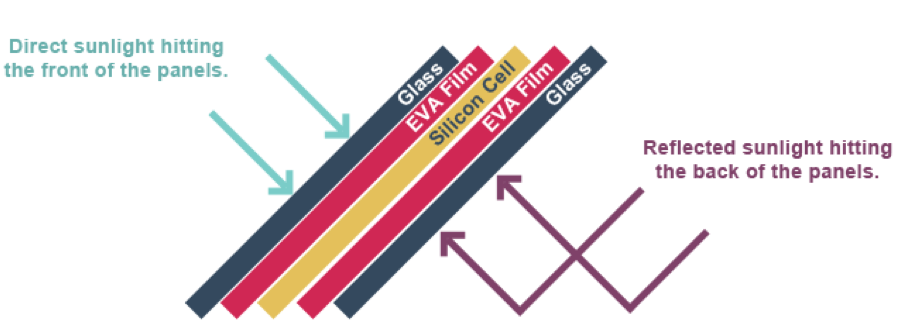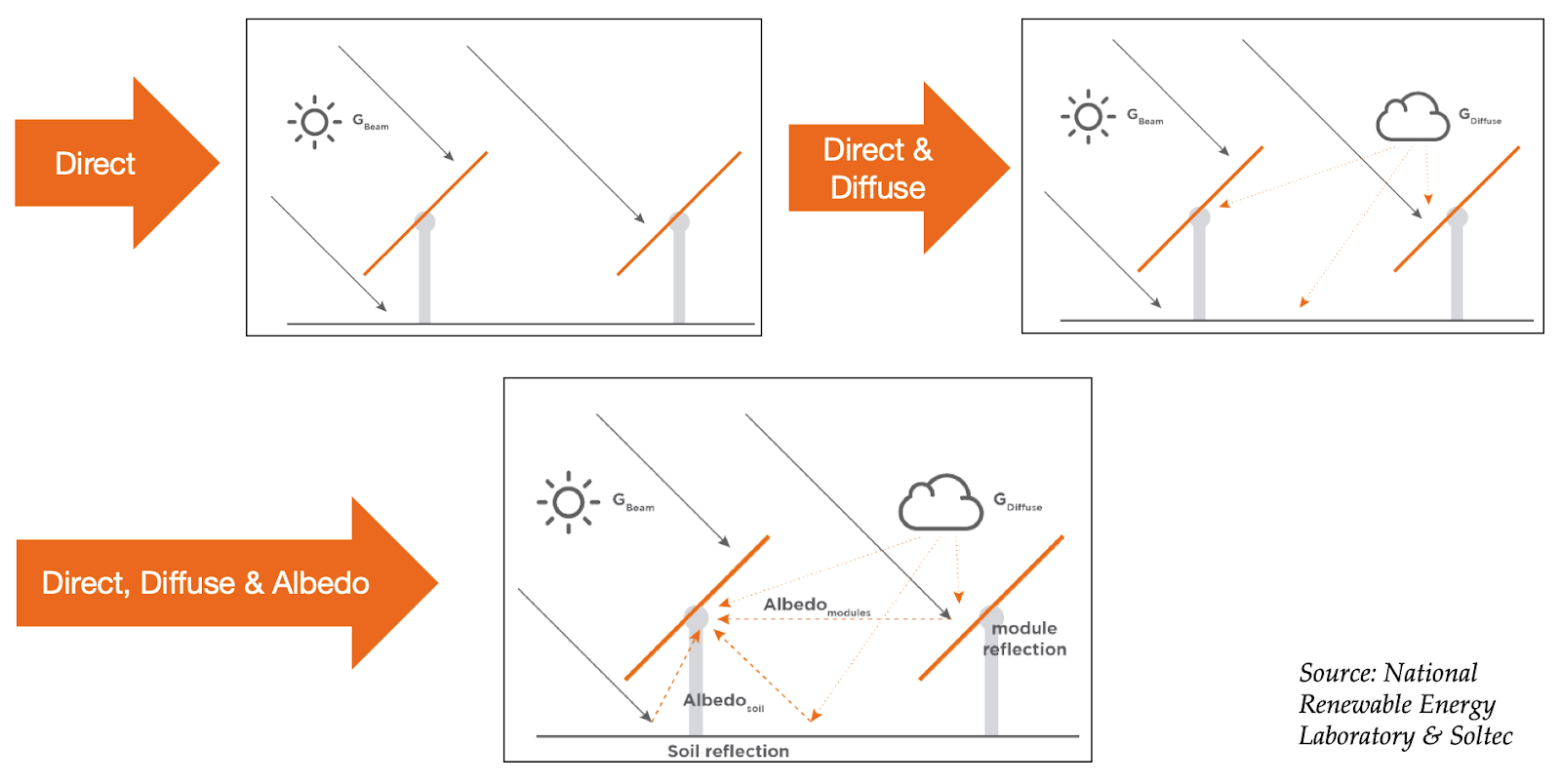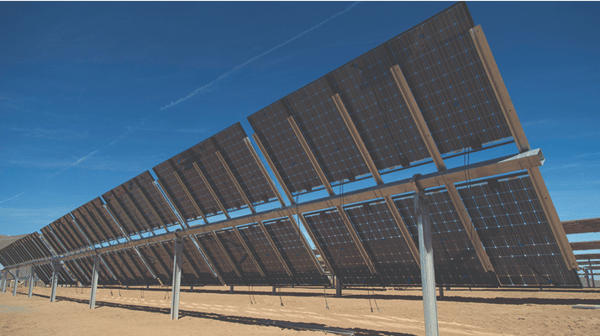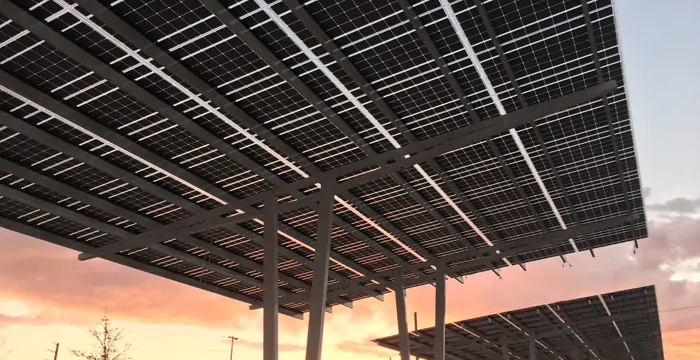Bifacial PV is currently a hot trend in solar. While bifacial panels are still more expensive than traditional monofacial panels, they offer a significant increase to energy production in the right circumstances. This means a quicker payback and a lower Levelized Cost of Energy (LCOE) for the solar project. In fact, a recent study conducted by Joule shows that bifacial-1T installations (meaning a bifacial solar array mounted on a single-axis tracker) increase energy yield by 35% and reach the lowest levelized cost of electricity (LCOE) for the majority of the world (93.1% of the land area).[1] These numbers are likely to improve as production costs continue trending downward and new efficiencies in the technology are discovered.
Bifacial solar modules offer many advantages over traditional solar panels because power can be produced from both sides of a bifacial module, therefore increasing total energy generation of the system (as much as 50% in some situations). Some experts are predicting that the market for bifacials will increase tenfold in the next four years. Today’s article will explore how bifacial PV works, the benefits of the technology, some limitations, and when you should (and shouldn’t) consider using them for your solar system.
What is a Bifacial Solar Panel?

Simply put, a Bifacial Solar PV is a solar module that can absorb light from both sides of the panel. Where traditional “monofacial” panels have a solid, opaque cover on one side, bifacial modules expose both the front and backside of the solar cells.
In the right circumstances, a bifacial solar panel has the ability to generate much more than a traditional solar panel. This is because they benefit from reflected light, diffuse light and albedo irradiance, in addition to direct sunlight on the face of the module. The illustration below shows how bifacials are capable of absorbing more light than standard solar panels.

- Direct - Sunlight absorbed on the front of the panel (same as a traditional solar panel)
- Diffuse - Sunlight diffused by clouds and other materials can now be absorbed by the rear of the panel when the front is pointed directly at the sun.
- Albedo - Highly reflective surfaces such as sand, concrete or even other solar panels offer additional means of reflecting light onto panels.
This is why the industry is so excited, as Bifacial Solar Modules opens a new world of system design possibilities, most of which improve the overall economics of solar.
Key Advantages of Bifacial Solar Panels
1. Total energy generation increased in the same sized (or smaller) footprint.
Bifacial Solar Panels can offer better performance at a similar project size (in the right circumstances). According to Joule, bifacial modules with single- and dual-axis trackers boost yield by 35% and 40%. As long as your system is built to let light through to the back of the panel, you increase your energy production without increasing the size of the system. Balance of system costs are reduced when more power can be generated in a smaller array footprint.
If you have limited space, you can now produce much more energy than you could with traditional panels. This applies primarily to systems that can take advantage of sunlight reaching the back of panels, particularly system designs where panels are raised, and not flush-mount (more on this later in the article).
2. Increased production at the same/similar installation cost.
Bifacial Solar Panels are generally similar size and shape to traditional panels, meaning that bifacial panels do not cost more to install. With increased generation at the same cost, you bring down the overall cost of installation for your project.
3. Optimal at locations with high albedo.
Sites that have reflective surfaces benefit immensely from Bifacial modules. Bifacial modules absorb sunlight reflected from the ground beneath the arrays and the surrounding objects. The more reflective the surface of your build... the more energy you can produce.
The sites with the highest albedo will include sand, bright coloured (or white) roofs, gravel, etc. but even grass and less reflective surfaces can have a positive effect on energy production.
4. Synergy between rear-facing exposure and improved ventilation.
While designing a system with enough space to permit light on the back of panel, there are some additional benefits inherent to the design of the system. One of the more important benefits is improving ventilation and operating temperatures for the modules when compared to systems that are built tightly together.
5. Improved durability and aesthetics
Some sources claim that Bifacial Solar Panels are more durable because both sides are UV resistant, and potential-induced degradation concerns are reduced when the bifacial module is frameless. They are also seen by some as a more "visually attractive" option, and have the potential to be used in more projects where aesthetics play a role (barriers, canopies, pergolas, brise-soleil, etc.).

Lumos Solar GSX bifacial modules[4]
When shouldn’t I use Bifacial Solar Panels?
Now that we've explored some of the benefits of bifacial solar panels, it's important to understand why they don't make sense all projects. Due to their increased cost over traditional monofacial solar panels, you need to ensure that your system can employ the benefits of a bifacial panel setup.
For example, one of the cheapest and easiest ways to build a solar system today is to utilize an existing roof with Southern exposure, and install as many flush-mounted panels as will fit. A system like this can minimize both racking and installation costs, and helps you start generating energy without too much red-tape or permits.
In this scenario, bifacial modules may not be worth it. With the modules mounted tightly together flat against the roof, there isn’t really enough room for light to get through to the backside of the panel. Even with a brightly-coloured roof, there still isn’t room for reflection if you have an array of solar panels installed tightly together.
Before you start your project, you absolutely need to determine what type of setup and system design works for your unique property, location, and the personal needs of you or your business. In many cases, this may include Bifacial Solar Panels, but there are certainly cases where the additional cost does not make sense.
Are Bifacial Panels the Future of Solar?
Obviously, just like every solar project, the design of a system will depend on many different factors. Monofacial Solar Panels still have their place and won't be going anywhere for a long time.
Having said that, many believe we are in a new era of PV where high-efficiency modules are supreme, and Bifacial technology is a key example of using higher quality materials for high-energy yields. “Bifacial modules are the future of the industry,” said Hongbin Fang, technical director of LONGi Solar. “It inherited all the advantages of mono PERC modules: high power density resulting in significant BOS savings, high energy yield with better low light performance and lower temperature coefficient. In addition, bifacial PERC modules also harvest energy from the rear side, demonstrating higher energy yield. We think bifacial PERC modules are the best approach to realize lower LCOE.”[3]
Furthermore, there are many solar PV technologies that are capable of even higher yields than bifacial panels, but their cost is still too high for them to make sense for many projects. The most obvious example of this is solar installations with dual-axis trackers. Dual axis trackers enable mounted solar panels to travel (as the name suggests) both up-and down, and left and right to follow the trajectory of the sun throughout the day. However, despite achieving the highest yield of energy generation among trackers, the cost is still too high to justify the increased production.
While there's many innovations to be made in the field of solar, bifacial solar panels seem like the next step due to their marginal affordability over traditional panels with the potential for much higher energy efficiency.

Bifacial Modules on Single-Axis Tracker
Are Bifacial Solar Panels right for me?
There’s only one way to answer that question—you’ll need to calculate the cost of a Bifacial solar panels over alternative options, and determine if the forecasted increase in energy production is enough to warrant the higher cost.
A feasibility analysis and preliminary system design is generally the first step to building your system. This takes into account your property, your buildings, your location, your azimuth, exposure to the sun and obstructions, and much more. With this information, you’ll have everything you need to go forward with your project. Most importantly, you'll have peace of mind knowing you have the optimal system for your budget and needs.
Stay Up-To-Date With the Compass Newsletter
Join the Compass Newsletter to stay up-to-date with the latest renewable energy news, regulatory updates, and resources designed to help navigate your renewable energy journey
It's our goal to advance the role of clean energy in North America by providing expert and nuanced advice to decision makers and offering a range of engineering services. Because renewable Energy is a long-term investment, we want to ensure you have all the information and resources you need to make informed decisions that drive the success of your project.
References:
[1] Rodriguez-Gallegos et al., Global Techno-Economic Performance of Bifacial and Tracking Photovoltaic Systems, Joule (2020), https://doi.org/10.1016/j.joule.2020.05.005
[2] C. Caufield, J. Guerrero, and NREL, “Large single-axis trackers for bifacial systems Soltec,” Bifacial PV Workshop, no. September. 2018.
[3] TaiyangNews Staff. (2018, July 3). Panel with TaiyangNews, LONGi Solar, Fraunhofer ISE and TUV discussed potential of bifacial solar technology at Intersolar Europe. Retrieved from taiyangnews.info: http://taiyangnews.info/technology/mono-perc-bifacial-the-next-big-thing-in-solar/
[4] Pickerel, K. (2018, April 2). What are bifacial solar modules? Retrieved from Solar Power World: https://www.solarpowerworldonline.com/2018/04/what-are-bifacial-solar-modules/




